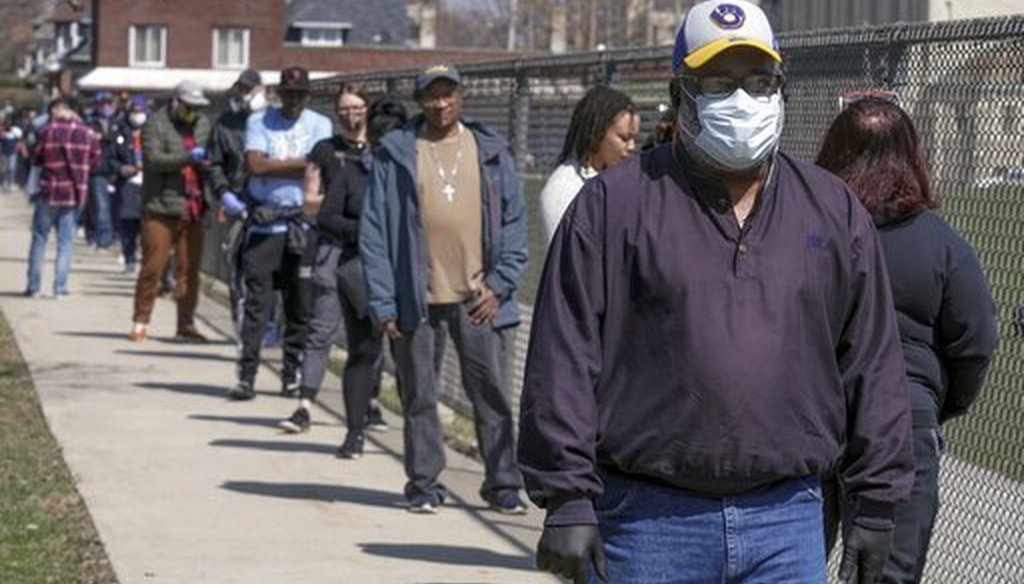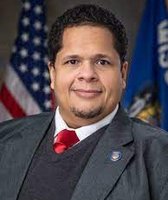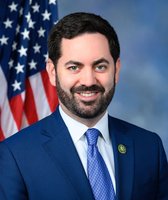Stand up for the facts!
Our only agenda is to publish the truth so you can be an informed participant in democracy.
We need your help.
I would like to contribute

In this April 7, 2020 file photo, voters observe social distancing guidelines as they wait in line to cast ballots in the presidential primary election in Milwaukee. (AP)
The 2020 election cycle has finally come to an end after what felt like a century — especially for fact checkers.
Wisconsin found itself at the center of the presidential race after President Donald Trump narrowly won the state in 2016. That meant a flurry of campaign events, both virtual and in-person, increased scrutiny of the state’s election practices and an avalanche of misinformation aimed at casting doubt on the democratic process.
That’s where we came in.
Here’s a sample of the election-related claims we checked in 2020.
"Very close to 160 million people are now working in the United States. Nobody's ever even come close to that number."
Sign up for PolitiFact texts
-- President Donald Trump
Before COVID-19 entered our lives, the economy was at the center of Trump’s reelection bid.
Trump made this claim during a January campaign rally in Milwaukee. The president was on point with the numbers, but when you compared the number of people employed against the number in the labor force, the nation was not quite at its peak.
We rated this Mostly True.
"40% of the initial small business funds didn’t go to small businesses at all."
-- President-elect Joe Biden
When Biden was still a candidate, he discussed the plight of small businesses and criticized the Paycheck Protection Program during a virtual event aimed at La Crosse voters.
We didn’t know the size of businesses receiving loans at the time, so Biden created his own definition of "small businesses" based on loan size — one that conflicted with the government’s definition under that program. It also conflicted with how he referenced small businesses a few sentences earlier to discuss their impact on the economy.
There was an element of truth here. The 40% figure roughly matched the portion of loans that topped $1 million, which given the purpose of the loan meant these companies had operating budgets of at least several million dollars.
But the way Biden explained this figure conflicted with both the government definition and his own definition from a moment earlier.
We rated this Mostly False.
Kanye West’s access to Wisconsin’s ballot was "denied by liberals."
-- Republican Party of Wisconsin
Ah, yes, the Kanye saga.
The rapper made a last-ditch effort to appear on Wisconsin’s Nov. 3 ballot as a member of the "Birthday Party," but his campaign failed to file his paperwork by the 5 p.m. deadline on Aug. 4. Democrats led a charge to toss out West’s nomination papers, citing the missed deadline and bogus signatures, and arguably had the most to lose if he appeared on the ballot.
But the final decision to block him was bipartisan, with both Democrats and Republicans on the Wisconsin Elections Commission agreeing with a staff recommendation that he filed the paperwork too late.
We rated this claim Mostly False.
"If you just count all the deaths in the red states, we are number two in the world in deaths, just behind Brazil."
-- Biden
When Biden visited Manitowoc in September, COVID-19 had consumed the presidential election.
If you define "red states'' by those that went for Trump in 2016, Biden’s claim at that point was spot on. Deaths in states with Republican governors, on the other hand, came in third behind Brazil and India.
Ultimately, though, no one can split the nation in half based on political parties to spin death counts one way or another.
We rated this Mostly True.
"Wisconsin (vote counters) took a break, and when they returned, Biden coincidentally came back ahead by 100k."
-- Facebook post
Social media has been inundated with misinformation about Wisconsin’s role in the election, including this claim.
Trump enjoyed a lead of more than 100,000 votes in Wisconsin early on election night, but Biden jumped ahead by about 8,000 votes after Milwaukee reported mail-in ballot results. His lead widened to around 20,000 after Green Bay and Kenosha finished their tallies.
So, two things: Biden never held a lead of 100,000 votes in Wisconsin and didn’t win the state by that margin. And some of the election results arrived late due to an influx of mail-in ballots — not because officials "took a break."
We rated this Pants on Fire.
"System 'Glitch' ... In Wisconsin - Reversal of Swapped Votes Removes Lead from Joe Biden."
-- Eric Trump
The president’s son tweeted this claim centered on Rock County and linked to an article from the far-right website Gateway Pundit bearing the same headline.
There was no glitch in the election system. And there was no "gotcha" moment or evidence that moved votes over to President Trump’s column.
The presidential totals were transposed for several minutes due to a data entry error by the Associated Press, without any involvement by election officials. The votes were counted following standard procedures by the Rock County clerk’s office and showed Biden winning the county by more than 9,000 votes.
We rated this Pants on Fire.
"Across the state the rejection rate for ballots went way down" in the Nov. 3 election.
-- Ben Wikler, state Democratic Party chairman
At the time of this statement by Wikler, it was too early to know how many ballots were rejected.
It may very well be true that the absentee ballot rejection rate was lower than past elections, but the Wisconsin Elections Commission said there was no data to confirm that. By looking at the 2016 rejected ballot rate compared with the improved April 2020 rate, there is a possibility the rejection will also be down for November 2020, but there is no data yet to confirm that.
Even Democrats subsequently acknowledged, "We don’t know exactly how many absentee ballots were rejected from this election (and won’t for a while)."
We rated this Mostly False.
"In Wisconsin, there are approximately 70,000 absentee ballots that do not have matching ballot applications as required by law."
-- Donald Trump
Every part of this was wrong.
Trump was actually referring to a group of 170,000 votes, not 70,000.
And that group of in-person absentee voters did indeed fill out an application in order to cast their ballot. It was part of the ballot certificate on the envelope, but that doesn’t make it any less valid since state statute doesn’t specify the nature of that application.
It’s the same approach that’s been used without issue in Wisconsin elections since 2010 — including the 2016 presidential contest that Trump won.
We rated this claim Pants on Fire.
Related:
Top Kenosha fact checks of 2020
Top Flip-O-Meter fact checks of 2020
Top Pants on Fire fact checks of 2020
Top COVID-19 fact checks of 2020
Our Sources
PolitiFact




















































